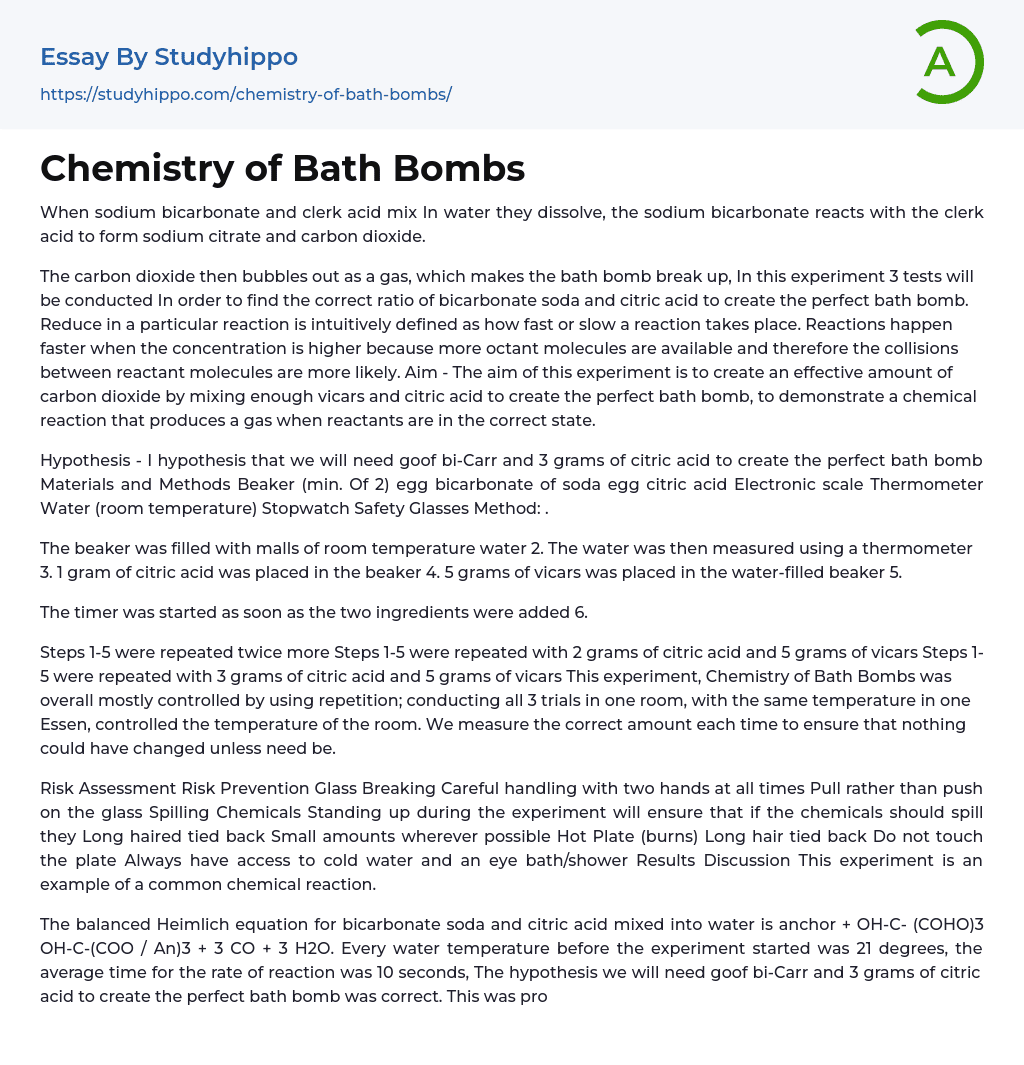When sodium bicarbonate and clerk acid mix In water they dissolve, the sodium bicarbonate reacts with the clerk acid to form sodium citrate and carbon dioxide.
The carbon dioxide then bubbles out as a gas, which makes the bath bomb break up, In this experiment 3 tests will be conducted In order to find the correct ratio of bicarbonate soda and citric acid to create the perfect bath bomb. Reduce in a particular reaction is intuitively defined as how fast or slow a reaction takes place. Reactions happen faster when the concentration is higher because more octant molecules are available and therefore the collisions between reactant molecules are more likely. Aim - The aim of this experiment is to create an effective amount of carbon dioxide by mixing enough vicars and citric acid to create the
...perfect bath bomb, to demonstrate a chemical reaction that produces a gas when reactants are in the correct state.
Hypothesis - I hypothesis that we will need goof bi-Carr and 3 grams of citric acid to create the perfect bath bomb Materials and Methods Beaker (min. Of 2) egg bicarbonate of soda egg citric acid Electronic scale Thermometer Water (room temperature) Stopwatch Safety Glasses Method: .
The beaker was filled with malls of room temperature water 2. The water was then measured using a thermometer 3. 1 gram of citric acid was placed in the beaker 4. 5 grams of vicars was placed in the water-filled beaker 5.
The timer was started as soon as the two ingredients were added 6.
Steps 1-5 were repeated twice more Steps 1-5 were repeated with 2 grams of citric acid an
5 grams of vicars Steps 1-5 were repeated with 3 grams of citric acid and 5 grams of vicars This experiment, Chemistry of Bath Bombs was overall mostly controlled by using repetition; conducting all 3 trials in one room, with the same temperature in one Essen, controlled the temperature of the room. We measure the correct amount each time to ensure that nothing could have changed unless need be.
Risk Assessment Risk Prevention Glass Breaking Careful handling with two hands at all times Pull rather than push on the glass Spilling Chemicals Standing up during the experiment will ensure that if the chemicals should spill they Long haired tied back Small amounts wherever possible Hot Plate (burns) Long hair tied back Do not touch the plate Always have access to cold water and an eye bath/shower Results Discussion This experiment is an example of a common chemical reaction.
The balanced Heimlich equation for bicarbonate soda and citric acid mixed into water is anchor + OH-C- (COHO)3 OH-C-(COO / An)3 + 3 CO + 3 H2O. Every water temperature before the experiment started was 21 degrees, the average time for the rate of reaction was 10 seconds, The hypothesis we will need goof bi-Carr and 3 grams of citric acid to create the perfect bath bomb was correct. This was proven in the experiment when g of vicars and g of citric acid was mixed with water, this mixture took the longest time to react and therefore would be a better product as a bath bomb.
The first two experiments where 1-2 grams of citric acid was used shows that he average rate of the reaction
was 10 seconds, however, when 3 grams of citric acid was used; the reaction took around 3-4 seconds more than the average. The factors that may affect the accuracy of the data include incorrect timing, incorrect measuring of the temperature and the amount of substances. The data was collected in one lesson over a period of approximately 50 minutes to ensure the data was accurate as possible.
The data could've been improved by ensuring the timing was exact, the mall of water measure could have been more precise, and the goof vicars and g of citric acid could have been exact by taking more time.
Conclusion The findings of this investigation are that the appropriate amounts of chemicals needed to create the perfect bath bomb are, 5 grams of bicarbonate soda and 3 grams of citric acid. Three experiments each with different amounts were conducted to find these results and it was decided that the best bath bombs should take the longest time to react.
- Acid Rain essays
- Bottled Water essays
- Acid essays
- Calcium essays
- Carbohydrate essays
- Carbon essays
- Chemical Bond essays
- Chemical Reaction essays
- Chemical reactions essays
- Chromatography essays
- Concentration essays
- Copper essays
- Diffusion essays
- Ethanol essays
- Hydrogen essays
- Organic Chemistry essays
- Osmosis essays
- Periodic Table essays
- Ph essays
- Salt essays
- Sodium essays
- Titration essays
- Atmosphere essays
- Biodiversity essays
- Coral Reef essays
- Desert essays
- Earth essays
- Ecosystem essays
- Forest essays
- Lake essays
- Natural Environment essays
- Ocean essays
- Oxygen essays
- Rainbow essays
- Sea essays
- Soil essays
- Volcano essays
- Water essays
- Wind essays




